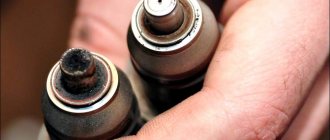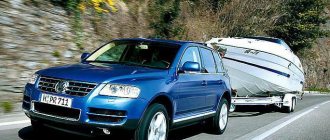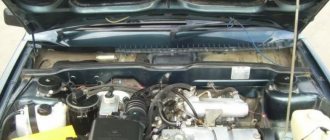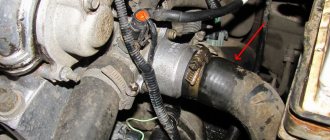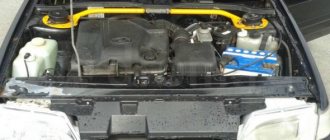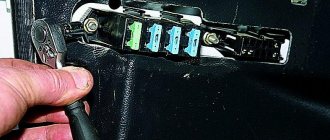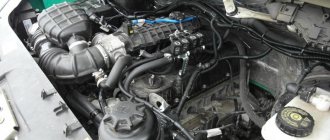Gradually, the carburetor was replaced by an electronic method of fuel injection. The emergence of new technologies is not perfect, and like any equipment, the injector has its own malfunctions that arise during long-term operation.
Among the main injector malfunctions are:
- Difficulty starting the engine.
- Unstable engine speed, and sometimes the engine stalls at idle.
- When driving in gear, the engine does not develop rated power. There are jerks and dips when starting to move, and fuel consumption has increased significantly.
If such malfunctions are detected, diagnostics of the injection system is required.
Diagnostics of the operation of VAZ 2110 injectors
Before carrying out diagnostics, it is necessary to remove the injector. To do this, disconnect the battery terminal and disconnect the air filter along with the inlet pipe. Pull out the vacuum tube from the special pressure regulator and disconnect the plug connections of the wires.
Unscrew the injector frame mounting bolts and remove the fuel pipe holder. To do this, you need to unscrew two screws. Now the ramp needs to be carefully moved.
Prepare 4 containers and place them under the nozzles. Connect the injector wiring to the plugs, connect the battery terminal and turn on the ignition. Gasoline should begin to spray evenly into the container. If there are leaks, replace the nozzle, as it is not sealed.
If gasoline does not spray, connect the battery directly to the injector. If the fuel begins to spray, then the fault lies in the electrical circuit.
The injector must also be replaced if the resistance of its windings does not correspond to 10-15 Ohms. This parameter is checked with an ohmmeter.
Repair
Before removing the injectors from the dismantled rack, it is advisable to check their functionality. To check you will need:
- four identical containers,
- tester,
- wires.
Functionality check
- Connect the gasoline supply and drain hoses and the power connector to the rail with injectors.
- Place the rack over the measuring cups.
Place the rack over the measuring cups
The shape of the cloud should be approximately the same for all nozzles
After the war, Germany received a ban on the development of injectors for aircraft engines. And engineers began adapting direct injection systems for passenger cars, discovering another important advantage compared to carburetors - efficiency.
Vladimir Berestenev
bvy.su
Replacement or flushing?
Some problems can be eliminated by cleaning and flushing. Others are “treated” only by replacement.
Table: problems with injectors
| Malfunction | Remedy |
| reduced performance | flushing, replacement if flushing fails |
| leakage | flushing, replacement if flushing fails |
| increased productivity | replacement |
| valve sticking | replacement |
| unstable valve sticking | flushing, replacement if flushing fails |
| overestimated or underestimated winding resistance | replacement |
In these cases, flushing is not a panacea. This method should be used taking into account the mileage and quality of service during operation.
During operation, the injector nozzles inevitably become coked and clogged with resinous deposits. The picture is aggravated by low-quality fuel, which can introduce additional pollutants.
For some time, fuel atomizers continue to operate without any visible changes, but sooner or later contaminants accumulate, changing the shape of the spray and reducing performance.
Injector life expectancy is limited even when using the cleanest fuel. Manufacturers recommend changing them every 100–120 thousand kilometers. Due to the fact that motorists use imperfect gasoline, and the one that can be bought at gas stations, the part has to be changed after 80-100 thousand km.
There is an opinion among motorists that “there is no need to interfere if everything works fine.” This opinion is justified, but only if the owner is ready to replace the nozzles with new ones approximately every 50 thousand kilometers.
The fact is that by getting rid of minor deposits as they accumulate, the owner extends the life of the consumable, since pollutants do not have time to cause irreparable damage.
Clogged injectors begin to interfere with normal operation after 30–50 thousand km. Initially, negative processes manifest themselves only in increased fuel consumption. Owners do not always associate the increased “appetite” of the engine with injectors, since there are many reasons for this phenomenon.
In the range of 50–80 thousand km, pollution, having accumulated, can cause interruptions in engine operation, which is no longer undetectable. It becomes clear that “you have to get into the injectors,” but cleaning them at this stage may be useless. When a clogged part is used for a long time, the diameter of the nozzle often increases. Flushing will remove contaminants, but the original parameters will not be restored.
How to check the ignition module of a VAZ 2110
The ignition module is a device designed to generate a high voltage electrical pulse that creates a spark to ignite the combustible mixture in the combustion chamber. A faulty ignition module can be judged for two reasons:
- The engine does not start due to lack of spark.
- The engine is running rough because there is not enough torque in all cylinders.
There are also other ways to determine faults. The first is to check the spark. To do this, disconnect the spark plug caps and attach them to new spark plugs that are grounded to ground. If there is no spark when the starter rotates, then try changing the high-voltage wires. If the spark also does not appear, then the problem is in the ignition module.
The second method is the simplest: change the ignition module and check the engine operation or spark. If the problem goes away, then the old module was faulty.
How does the ECU control the injectors?
The fact that the opening of the injector is controlled by the ECU is, in general, understandable. But the real question is: how exactly does the ECU control it? That is, how does it regulate the degree of opening of the nozzle? The frequency of the pulses (then what are these pulses - voltage, current, frequency?) or simply a change in the voltage supplied to the injector (if so, then within what limits)?
I would appreciate your answer Thank you
| QUOTE (akd @ May 24 2005, 05:48 AM) |
| The frequency and duration of the pulses supplied to the injector are adjusted. |
This is completely true only for central injection.
On distributed injection, the algorithms can be more complex. From a simple pulse (pulse duration changes), to a series of pulses each time each injector is opened (for example, the first powerful opening pulse, then a small supporting pulse(s))
But in any case, as “akd” correctly noted, the injector works in the key
mode.
I was talking about the mono-injection nozzle.
Ok, let me rephrase the question slightly: how can I make the injector open more often/for longer?
Source vwts.ru
On injection engines of VAZ 2108, 2109, 21099 cars, fuel injection is controlled by an electronic engine control system - ECM.
One of the main tasks of the ECM of VAZ 2108, 2109, 21099 cars is to regulate the amount of fuel injected into the engine cylinders depending on its operating mode. The injection dose is changed by adjusting the duration of opening of the fuel system injectors. The calculation of the opening time of the injectors and the sending of a command (impulse) to open is carried out by the electronic control unit (ECU) of the ECM. The longer the pulse from the ECU, the longer the injectors are open, the greater the volume of injected fuel and vice versa. The ECU calculates the pulse duration based on data on the current state of the engine received from the ECM sensors.
Another main task of the ECM is to adjust the ignition timing , again depending on the engine operating mode.
Let's consider the operating procedure of the fuel injection system of VAZ 2108, 2109, 21099 cars at different engine operating modes.
Starting the engine
After turning the key in the ignition switch, the following occurs:
— The ECU and the APS (automotive anti-theft system - immobilizer) exchange impulses. The ECU sends a request to the APS unit and receives a special code in response. After comparing the code with the data stored in memory, the ECU makes a decision to allow the engine to start or, conversely, to block the start.
— The main relay and the fuel pump relay turn on (you can hear a clicking and buzzing sound). The fuel pump creates the necessary pressure in the fuel rail. After which it turns off after 3-5 seconds (relay click).
— The ECU checks the engine temperature (signal from the temperature sensor) and, in accordance with it, calculates the volume of injected fuel and the required ignition timing.
After cranking the crankshaft with the starter, the following occurs:
— Having received a signal from the crankshaft position sensor (CPS) about the start of rotation of the engine crankshaft, the control unit gives a command to inject fuel simultaneously with all injectors (so-called asynchronous injection). This ensures stable engine starting. The ECU will operate in starting mode until the shaft speed exceeds 500 rpm or the cylinder purge mode begins (spark plugs are flooded).
— The ECM synchronizes its operation with the operation of the vehicle engine. Synchronization (determining the injection moment) is carried out according to the readings of the crankshaft position sensor. The passage of two missing teeth onto the crankshaft pulley in the DPKV field creates the passage of two pulses from the DPKV to the control unit. Using them, the ECU determines whether the piston has passed TDC in the 1st and 4th cylinders of the engine and gives the injection command.
Idling
— The computer analyzes the readings from the crankshaft position sensor (CPS), the throttle position sensor (TPS), the coolant temperature sensor (DTOS), the mass air flow sensor (MAF) and, in accordance with them, sets the required number of shaft revolutions.
— Gives a command to the idle air regulator (IAC), regulating the amount of opening of the bypass (air) channel and, accordingly, the volume of air entering the cylinders.
— Gives a command to the injectors, increasing the injection duration on a cold engine and decreasing it as the engine warms up. Therefore, when the engine is not warmed up, the idle speed is higher, the fuel mixture is richer, and as it warms up, the idle speed returns to normal.
— In systems with feedback (adjusting the composition of the fuel mixture according to readings from the lambda probe), when the engine warms up, data from the lambda probe is not taken into account.
Medium loads
— When the car is moving, the ECU analyzes signals from the ECM sensors: DPKV (information about the crankshaft rotation speed), TPS (information about the throttle position), mass air flow sensor (information about the volume of air entering the engine), speed sensor (the car is moving or standing). Based on the data obtained, the injection dose is calculated (fuel mixture composition 14.7/1), the ignition timing is calculated, and a pulse of a certain length is given to open the injectors.
— In systems with adjustment of the fuel mixture according to the readings of the oxygen sensor (feedback), the volume of injected fuel is calculated taking into account the signal from the DC (poor - rich mixture). This ensures the normal operation of the exhaust system catalytic converter. When the engine warms up, the DC readings are not taken into account by the control unit.
— To ensure good driving characteristics of the vehicle when driving with a cold engine, the ECM system prepares a richer fuel mixture and sets earlier ignition timing.
Power mode
— The ECU constantly monitors the position of the throttle valve (signal from the DPS sensor) and the amount of air entering the engine (signal from the mass air flow sensor). Driving the vehicle with the throttle wide open causes the fuel mixture to become richer and the ignition timing to change in order to obtain more power from the vehicle's engine.
— The ECU, controlling the injection duration, sets the ratio of fuel and air in the mixture to 12/1 (stoichiometric 14.7/1). In systems with feedback (correction of the mixture composition using a lambda probe), when the power mode occurs, data from the lambda probe is not taken into account.
Acceleration mode
— A sharp press on the gas pedal causes a strong enrichment of the fuel mixture and a change in the ignition timing in order to obtain the most power from the car engine.
— The ECU, having received a signal from the throttle position sensor about a sharp opening of the throttle, from the mass air flow sensor about a sharp increase in the volume of air entering the engine, briefly further enriches the fuel mixture, increasing the duration of the pulse to the injectors and increasing the ignition timing.
Forced idle
— The ECU sets the idle speed control to such a position that in the event of a sharp closing of the throttle valve (signal from the throttle position sensor) while the vehicle is moving, it slightly opens the bypass channel to the required amount to allow air to enter the engine (ensuring the required idle speed).
— When the car is moving with the throttle valve closed (engine braking, gear shifting), the ECU, in accordance with the TPS readings, the MAF reduces the volume of injected fuel, reducing the pulses going to the injectors. This ensures normal mixture formation and reduces the release of harmful substances.
Notes and additions
In addition to the above, the ECM of VAZ 2108, 2109, 21099 cars performs several more functions when the injection system is operating.
— Voltage drop compensation
— A drop in voltage in the system (for example, when powerful consumers are turned on) leads to a weakening of the spark in the ignition system. To compensate for this phenomenon, the ECU commands to increase the energy accumulation time in the ignition coils and increase the pulse to the injectors. Also, at idle, by changing the IAC position, the volume of air entering through the bypass channel increases in order to maintain stable idle speed.
— Shutting off the fuel supply after turning off the ignition
— After turning off the ignition and the control unit with DPKV receiving a signal that the engine is not running, fuel is not supplied to the injectors. This prevents glow ignition - self-ignition of the fuel mixture in a hot engine. In addition, the fuel supply is stopped when the engine crankshaft speed exceeds 6510 rpm.
More articles on the VAZ injector
Source twokarburators.ru
The time when various engine operating parameters were set or adjusted using mechanics or primitive electrical devices has long passed. Modern cars use an electronic engine control unit (ECU) that controls everything.
He is responsible for all settings, for changes in engine operating modes, for fuel supply, for mixture ignition processes, etc. The ECU is essentially the brain of the engine, which is capable of collecting information, analyzing it, and then drawing conclusions and sending signals to execution devices.
The electronic engine control unit is a programmable system, which initially contains certain digital parameters for the operation of certain engine components for certain operating modes.
And if you look at it, the ECU compares the reference performance indicators with the real characteristics and tries to adjust the real indicators to the reference values. Moreover, all this is done instantly thanks to the digital processor, which is the main element of the electronic engine control unit.
The ECU analyzes information not only about engine operating characteristics, but also information about external factors. The ECU is an open system. It is connected to other electronic vehicle control systems. And when making decisions, i.e. When a signal is sent to the execution device, it takes into account the operating parameters of other car systems.
ECU design and placement
The board on which the electronic parts are located is housed in a metal case. The connection to sensors and electrical power occurs through a special connector.
Inside the ECU there are not only electronic circuits responsible for launching certain control devices, but also a memory unit in which all information about processes is stored, and information about failures in engine operating systems is also stored there. The heart of the ECU is the microprocessor.
When the ECU operates, quite a lot of heat is generated, which cannot but affect the electronic components of the control unit. Therefore, the system can use different heat removal principles.
The electronic engine control unit is located directly on the engine or close to it. This arrangement of the block should affect the thermal stability of the device and the ability to withstand vibration.
Which sensors are connected to the electronic engine control unit:
• Camshaft position sensor. • A sensor that monitors the angle of rotation of the crankshaft and its speed. • Engine knock sensor. • Oxygen sensor. • Cooling fluid temperature sensor. • Air temperature sensor. • Mass air flow sensor. • A sensor that monitors the pressure in the intake manifold. • A sensor that controls the position of the throttle valve.
The ECU receives messages from sensors constantly in real time. And it immediately sends commands to change operating parameters to the actuators. Even the smallest change in parameters immediately finds its reaction in the operation of the electronic unit. Naturally, neither the driver nor the passengers of the car notice such actions. But this does not mean that the electronic unit does not fulfill its tasks.
Simultaneously with receiving impulses or signals from the sensors, the ECU monitors the problems of the sensors themselves. Those. If the sensors operate inadequately, an error signal is immediately generated. And not only sensors, but also actuators. All data then goes into memory and is stored there. In the event of a malfunction, the error message, which is stored in memory, makes it possible to determine the problem location in the engine or sensors.
Any changes in parameters (temperature, crankshaft speed, etc.) cause the ECU to immediately react in the form of changes in the amount of fuel, ignition timing, etc.
To which actuators (devices) does the ECU send commands:
• Injectors, which are responsible for injecting fuel into the engine cylinders. Those. The dose of injected fuel varies depending on many factors. And here it is important how quickly the injectors work, how their control devices react to changing situations.
• Ignition coil or coils (depending on the engine model). They are responsible for the moment at which a spark will be supplied to the engine cylinders.
• In addition, there are other actuators to which an impulse or signal is sent, depending on the situation.
• The ECU has an output to a special connector to which diagnostic equipment is connected in case of checking the operation of the ECU and the engine.
• There is a light indicator that gives signals about errors, both in the engine and in the ECU itself.
What signals does the ECU receive?
The signals operated by the electronic engine control unit can be analogue or digital. Moreover, analog signals are those that come from sensors. Internal units allow you to convert analog signals into digital ones, which are understandable to the ECU processor.
It is with digital signals that the processor works and performs certain actions with them. Most of the signals coming from sensors are analog and require conversion. Although some sensors receive digital signals that do not require conversion, but are immediately processed by the processor.
In addition, there are also pulse signals that can immediately provide information, for example, on the crankshaft rotation speed. Pulse signals must also be converted to digital, since the processor does not perceive anything other than digital signals.
It should be said that often the signals coming from sensors may have some interference. In order to cut off interference, a special filter system is used to filter out unnecessary signals. Those. Only significant signals are sent to the processor.
In addition, the signals coming from the sensors may have a higher voltage than that for which the ECU is designed. To reduce the signal voltage, protective circuits are installed.
Source autodrop.ru
Video - Checking sensors with the engine running
For example, the cooling fan activation sensor is checked to bring the car to the temperature at which this element should operate. If the fan does not work, then, first of all, the fan itself is checked. It is connected directly to the battery, and if it starts to rotate, then the fault lies in the sensor.
Some types of sensors are tested using diagnostic equipment, which can give a hundred percent answer. To do this, the sensor is dismantled and connected to special devices.
Which is better: carburetor or injector?
And now a little about which VAZ-2110 engine will be more reliable: an injector or a carburetor? But you need to look at this issue from different angles. For example, beginners will like the injector. Constant speed, there is no need to shut off the air supply in cold weather, and starting off is much easier. But there is another advantage - the car is more responsive at high speeds. Even at a speed of 120 km/h, when you press the gas pedal, the car quickly picks up speed. With carburetor engines this happens much more slowly. Therefore, overtaking in a car with an injector is safer. But when starting from a traffic light, the carburetor will easily “break” the injector. And the reason is higher torque at the bottom. And the cost of maintenance, of course, is higher for injection “tens”, since sometimes it is not easy to make an accurate diagnosis in the event of a breakdown.
